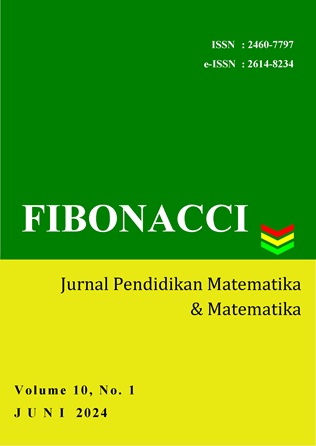ANALISIS KEMAMPUAN BERPIKIR KREATIF MATEMATIS DITINJAU DARI SELF EFFICACY DALAM MENYELESAIKAN SOAL BERBASIS LITERASI DAN NUMERASI
Main Article Content
Abstract
Article Details
Authors who publish with this journal agree to the following terms:
- Authors retain copyright and grant the journal right of first publication with the work simultaneously licensed under a Creative Commons Attribution License that allows others to share the work with an acknowledgement of the work's authorship and initial publication in this journal.
- Authors are able to enter into separate, additional contractual arrangements for the non-exclusive distribution of the journal's published version of the work (e.g., post it to an institutional repository or publish it in a book), with an acknowledgement of its initial publication in this journal.
- Authors are permitted and encouraged to post their work online (e.g., in institutional repositories or on their website) prior to and during the submission process, as it can lead to productive exchanges, as well as earlier and greater citation of published work (See The Effect of Open Access).
References
Albert, B. &. (1993). Perceived SelfEfficacy in cognitive development and functioning. Educational Psychologist.
Alfansyur, A., & Mariyani. (2020). Seni Mengelola Data : Penerapan Triangulasi Teknik , Sumber Dan Waktu pada Penelitian Pendidikan Sosial. Historis, 5(2), 146–150.
Ananda, E. R., & Wandini, R. R. (2022). Analisis Kemampuan Literasi Matematika Siswa Ditinjau dari Self Efficacy Siswa. Jurnal Obsesi : Jurnal Pendidikan Anak Usia Dini, 6(5), 5113–5126. https://doi.org/10.31004/obsesi.v6i5.2659
Aripin, U., & Purwasih, R. (2017). Penerapan Pembelajaran Berbasis Alternative Solutions Worksheet Untuk Meningkatkan Kemampuan Berpikir Kreatif. AKSIOMA: Jurnal Program Studi Pendidikan Matematika, 6(2), 225. https://doi.org/10.24127/ajpm.v6i2.989
Arista, E. D. W., & Mahmudi, A. (2020). Kemampuan berpikir kreatif matematis dalam penyelesaian soal open-ended jenis PISA berdasarkan level sekolah. Pythagoras: Jurnal Pendidikan Matematika, 15(1), 87–99. https://doi.org/10.21831/pg.v15i1.34606
Bandura, A & Locke E, A. (2003). Negative Self-Efficacy and Goal Effects Revisited. Journal of Applied Psychology.
Bandura, a, Barbaranelli, C., Caprara, G. V, & Pastorelli, C. (2008). Mata Kuliah Psikodiagnostika Umum Pada Mahasiswa Magister Profesi Psikologi di Universitas “ X ” Penelitian Oleh : Evany Victoriana , M . Psi , Psikolog FAKULTAS PSIKOLOGI. Child Development, 72(1), 187–206. http://www.ncbi.nlm.nih.gov/pubmed/15350854
Bandura, A. (1997). Self-Efficacy The Excercise of Control. USA: W. H Freeman and Company.
Kadir, I. A., Machmud, T., Usman, K., & Katili, N. (2022). Analisis Kemampuan Berpikir Kreatif Matematis Siswa Pada Materi Segitiga. Jambura Journal of Mathematics Education, 3(2), 128–138. https://doi.org/10.34312/jmathedu.v3i2.16388
Kamalia, N. A., & Ruli, R. M. (2022). Analisis Kemampuan Berpikir Kreatif Matematis Siswa Smp Pada Materi Bangun Datar. Jurnal Edukasi Dan Sains Matematika (JES-MAT), 8(2), 117–132. https://doi.org/10.25134/jes-mat.v8i2.5609
Mailani, E. (2015). Penerapan Pembelajaran Yang Menyenangkan. Elementary School Journal PGSD FIP Unimed, 1(1), 8–11.
Mills N, P. F. & H. (2006). A Reevaluation the Role of Anxiety: Self Efficacy, Anxiety, and Their Relation to Reading and Listening Proficiency. Foreign Language Annals.
Munandar, U. (2012). Pengembangan Kreativitas Anak Berbakat. Rineka Cipta.
Nadjafikhah, M., Yaftian, N., & Bakhshalizadeh, S. (2012). Mathematical creativity: Some definitions and characteristics. Procedia - Social and Behavioral Sciences, 31(2011), 285–291. https://doi.org/10.1016/j.sbspro.2011.12.056
Ningrum, H. U., Mulyono, Isnarto, & Wardono. (2019). Pentingnya koneksi matematika dan self-efficacy pada pembelajaran matematika SMA. Prisma : Prosiding Seminar Nasional Matematika, 2, 679–686.
Noer, S. (2012). Self-Efficacy Mahasiswa Terhadap Matematika. Seminar Nasional Matematika Dan Pendidikan Matematika, November, 801–808.
Nudiati, D. (2020). Literasi Sebagai Kecakapan Hidup Abad 21 Pada Mahasiswa. Indonesian Journal of Learning Education and Counseling, 3(1), 34–40. https://doi.org/10.31960/ijolec.v3i1.561
Rozi, F. A., & Afriansyah, E. A. (2022). Analisis Kemampuan Berpikir Kreatif Matematis Berdasarkan Disposisi Matematis Peserta Didik. Journal of Authentic Research on Mathematics Education (JARME), 4(2), 172–185.
Siswono, T. Y. E. (2006). Desain Tugas untuk Mengidentifikasi kemampuan berpikir Kreatif Siswa dalam Matematika. Pancaran Pendidikan, 63, 495–509.
Siswono, T. Y. E. (2010). Leveling Student’s Creativity in Solving and Posing Matehematical Problem. IndoMS. J.M.E, 1(1), 17–40.
Sugilar, H. (2013). Meningkatkan Kemampuan Berpikir Kreatif Dan Disposisi Matematik Siswa Madrasah Tsanawiyah Melalui Pembelajaran Generatif. Infinity Journal, 2(2), 156. https://doi.org/10.22460/infinity.v2i2.32

